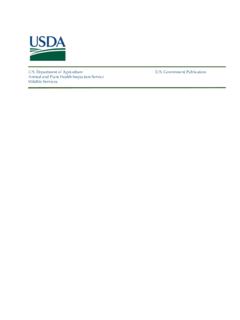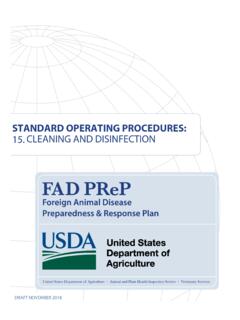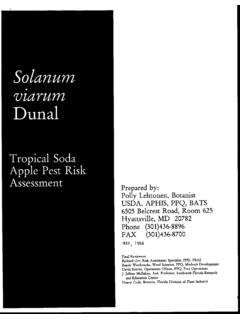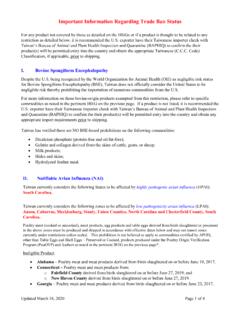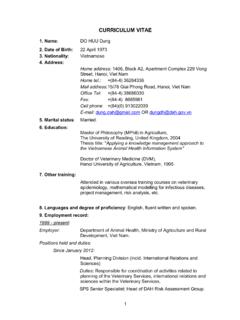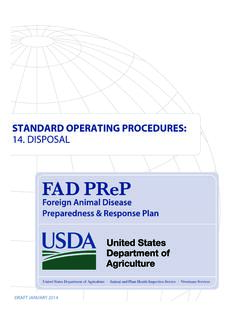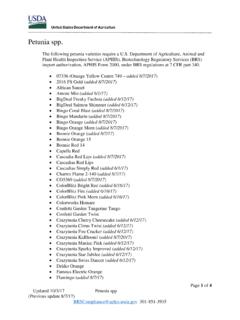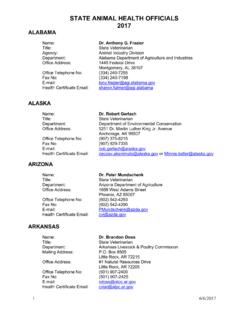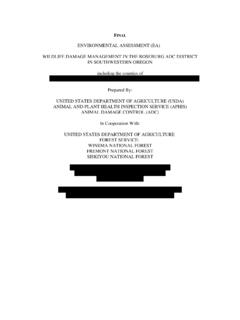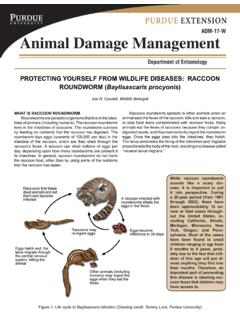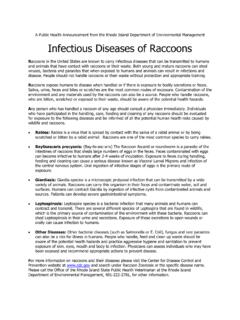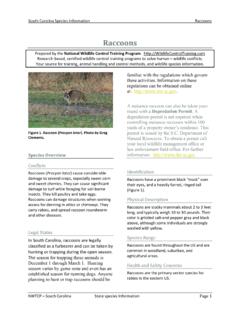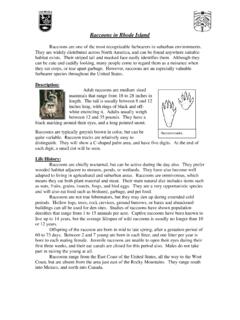Transcription of North America Range - USDA APHIS
1 IDENTIFICATION raccoons are mammals with a distinctive black mask over the eyes and rings on their bushy tails. raccoons weigh from 10 to 30 pounds and are two to three feet long. raccoons are salt and pepper gray and black al-though some appear washed with a yellow color. HABITAT raccoons are commonly found in areas with water and trees. raccoons den in hol-low trees, ground burrows, brush piles, muskrat houses, barns, abandoned buildings, dense clumps of cattails, haystacks or rock crevices. raccoons also live success-fully in urban areas. HABITS raccoons are omnivores. This means they eat both plants and animals. Plant foods include all types of fruits, berries, nuts, acorns, corn and other types of grain.
2 Animal foods are crayfish, clams, fish, frogs, snails, in-sects, turtles, turtle eggs, mice, rabbits, muskrats and the eggs and young of ground-nesting birds. raccoons normally breed in February or March. Gestation period is about 63 days. Most litters are born in April or May. Only one litter of young is raised each year. Average litter size is three to five kits. The young open their eyes at about three weeks and are weaned between two and four months. The female, called a sow, and her young will usually remain together for the first year and the young will often den for the winter with her. The following spring the yearlings go off on their own. raccoons are nocturnal. This means they are most active at night.
3 Adult males, called boars, travel an area of three to 20 square miles. A female raccoon will travel one to six square miles. Rac-coons do not hibernate, but they do hole-up in dens and become inactive during se-vere winter weather. Raccoon populations are made up mostly of young ani-mals. In the fall, one-half to three-fourths of the raccoons are less than one year old. On very rare occasions a raccoon can live to be 12 years old in the wild. Contrary to popular myth, raccoons do not always wash their food before eating, although they frequently play with their food in water. North America Range raccoons are found throughout the United States. However, they are not found at the higher eleva-tions of mountainous regions and in some areas of the arid South-west.
4 raccoons are common in the wooded eastern part of the United States. Procyon Living in harmony .. Most of the time, raccoons and humans live in harmony. people enjoy watching raccoons in the wild raccoons provide millions of dollars to the economy by those hunting them raccoons have excellent fur, making it very valuable for clothing and it is a renewable re-source raccoons provide a food resource in some parts of the Living in conflict .. raccoons sometimes carry rabies raccoons prey on poultry, quail, pheasants, turkeys, young and eggs of waterfowl raccoons cause damage to crops such as corn, melons, fruits, vegetables and grains raccoons are an urban pest when they get into trash, into people s homes and chimneys raccoons can spread parasites like round-worms from fecal droppings to pets and humans raccoons spread distemper to pets and other animals Because they will eat just about anything, raccoons almost never starve.
5 The best way to prevent damage by raccoons is to keep them out of an area. Fence them out by using an electric fence turned on at night. Store garbage in cans with tight fitting lids. Cans should be secured to a rack to keep rac-coons from tipping them over. To keep raccoons out of chim-neys, fasten a heavy screen or cap designed to keep birds and mammals out of the chimney. It is difficult to scare raccoons away by modifying their envi-ronment or by using devices to scare raccoons . There are no repellents that work to persuade raccoons to stay away from an area. Because they have a fairly large territory, a neighborhood or community-wide effort may be needed to solve raccoon problems. First step is to remove sources of food, water and shelter.
6 Do not feed raccoons ! raccoons are easy to catch in live traps, but it takes a sturdy trap to hold one. Studies show relocated raccoons tend to cause problems in new areas. Regulated trapping and hunting are the most effective control techniques in managing raccoons . However, shooting in most towns and cities is illegal. Hind foot is 4 1/2 inches Suffix vore means .. Vore comes from the suffix vorous which means eating. Omni means all. raccoons are omnivores. These means they eat both plants and animals. List five other omnivores. _____ Use a dictionary and define carnivore: _____ List two carnivores: _____ Use a dictionary to define herbivore: _____ List two herbivores: _____ raccoons can be serious pests.
7 They have been known to prey on pets and can damage crops. raccoons may carry diseases such as canine distemper, trichinosis, rabies, leptospirosis, tularemia and Chagas disease. A big concern with raccoons is that they might carry and spread rabies. A new rabies vaccine for raccoons has been developed. Now just how do you go about vaccinating rac-coons in the wild? Researchers have found that they can drop food with the vaccine in it from airplanes. The rac-coons find the food and eat it and become vaccinated against rabies. Unfortunately, raccoons will sometimes eat the eggs and young of endangered animals like the sea turtle. ACROSS: 3. renewable, 5. sow, 6. repellents, 8. kits, 10. furbearer, 11.
8 Omnivore DOWN: 1. herbivore, 2. rabies, 3. raccoon, 4. carnivore, 7. litter, 9. urban The name raccoon comes from the Algonquian Indian word arakun, meaning scratches with his hand. The species name, lotor, is Latin for washer and refers to the raccoon s habit of washing food with its front paws. In the United States, raccoons have been harvested for fur through regulated trapping. Raccoon fur harvesting generated $400,000 in 1934 and $ million in 1980. The raccoon is the most economically important of all the fur-bearing animals harvested. During the roaring 20s and the 30s, the coon skin coat was in style. In the 1950s when Davy Crockett and Daniel Boone were made popular through television and movies, the coon skin cap was very popular for young boys.
9 This activity sheet has been developed by usda Wildlife Services. For more information about raccoons contact your state s Wildlife Services office or usda Wildlife Services at 301 734-7921. Wildlife Activity Book and 1998 Wildlife Issue of the Colorado Reader Colorado Foundation for Agriculture Box 10 Livermore, CO 80536 Prevention and Control of Wildlife Damage CD ROM or Handbook 202 Natural Resource Hall University of Nebraska Box 83819 Lincoln, NE 68583 Jack H. Berryman Institute for Wildlife Damage Management Utah State University Logan, Utah 83431-5210 ACROSS 3. resource that grows or is replaced 5. female raccoon 6. chemicals used to repel animals 8.
10 Young raccoons 10. animal that is important for its fur 11. animal that eats both plants and animals DOWN 1. an animal that eats plants 2. disease raccoons often carry 3. Procyon lotor 4. an animal that eats other animals 7. group of young born to a raccoon 9. opposite of rural by YouDec 17,1998 1 2 3 4 5 6 7 8 9 10 11
